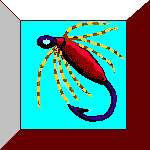
Short Key to Mayfly Genera of North America
This simple key permits the easy identification of mayfly nymphs and adults down to the genus level. Identification of the exact species is
more difficult, often requiring the use of a microscope. To use this key simply start at the top and select the appropriate member of the pair.
(ie nymph or adult). If a number follows your choice, go to that number and choose one of that pair (and so on). If a name follows your choice
(ie Ephemeridae) you have identified the Family to which your insect belongs. Click on this name and proceed in the same manner to
identify the genus to which your insect belongs. Click on the genus name to read a brief description of the genus and some of the most common
species. (I am still writing this last part, so please be patient.)
Links will be provided to illustrate and explain the technical terms.
Natural History and Anatomy of the Mayfly
Key to the Mayfly Species of Great Britain
INSECT STAGE
Nymph
Adult

NYMPH FAMILY KEY
1. Legs flanged for burrowing;
mandibles bearing long tusks---------------------Ephemeridae
1. Legs cylindrical or flattened in cross-section;
mandibles without long tusks---------------------2
2. Gills of abdominal segment 2 operculate,
almost entirely covering remaining gills---------Caenidae
2. Gills of abdominal segment 2 absent or,
if present, not operculate-----------------------3
3. No gills on segments 1-2 (in some cases, 1-3)----Ephemerellidae
3. Gills on segments 1-7 or 1-6---------------------4
4. Gills on segments 1-6 (largely concealed by
carapacelike extension of mesonotum)-------------Baetiscidae
4. Gills on segments 1-7----------------------------5
5. Body strongly flattened;
eyes on dorsal surface of head-------------------Heptageniidae
5. Body not strongly flattened----------------------6
6. Tails clothed with short hairs on both sides-----Leptophlebiidae
6. Outer pair of tails with hairs on inner
(mesal) sides only-------------------------------7
7. Front tarsal claw double-------------------------Ametropidae
7. Front tarsal claw single-------------------------Baetidae

NYMPH GENERA KEY
EPHEMERIDAE
1. Frontal prominence of head deeply forked---------------------------Ephemera
1. Frontal prominence of head rounded---------------------------------Hexagenia
CAENIDAE
1. Operculate gills of abdominal segment 2 triangular-----------------Tricorythodes
1. Operculate gills not triangular------------------------------------2
2. Operculate gills with inner margins overlapping,
outer margins rounded; head with prominent tubercules--------------Brachycercus
2. Operculate gills nearly rectangular, not overlapping
at inner margins; head without tubercules--------------------------Caenis
EPHEMERELLIDAE
This family contains but one common genus-----------------------------Ephemerella
BAETISCIDAE
This family contains but one genus------------------------------------Baetisca
LEPTOPHLEBIIDAE
1. Gills of abdominal segment 1 deeply cleft, of segments
2-7 broad, platelike, with long apical extensions------------------Leptophlebia
1. Gills of abdominal segments 1-7 alike, deeply cleft----------------Paraleptophlebia
BAETIDAE
1. Gill tufts at base of maxillae and at foreleg bases---------------Isonychia
1. No gill tufts at base of maxillae or foreleg bases----------------2
2. Posterolateral angles of abdominal segments prolonged
as thin, flat spines----------------------------------------------Siphlonurus
2. Posterolateral angles of abdominal segments not
prolonged as spines-----------------------------------------------3
3. Gills single------------------------------------------------------4
3. Gills double or, if single, bearing a recurved flap---------------6
4. Hind wing pad absent----------------------------------------------Pseudocloen
4. Hind wing pad present---------------------------------------------5
5. Middle tail as long as outer tails--------------------------------Centroptilum
5. Middle tail shorter than outer tails------------------------------Baetis
6. Hind wing pad present---------------------------------------------Callibaetis
6. Hind wing pad absent----------------------------------------------Cloen
AMETROPIDAE
1. Maxillary palp two-segmented--------------------------------------Metretopus
1. Maxillary palp three-segmented------------------------------------Siphloplecton
HEPTAGENIIDAE
1. Gills of abdominal segment 7 slender, fingerlike------------------Stenonema
1. Gills of all segments platelike-----------------------------------2
2. Gills of abdominal segments 1 and 7 enlarged, each pair
converging beneath the abdomen to form, with other gills,
an adhesive disk--------------------------------------------------Rithrogena
2. Gills in normal position, not modified as above-------------------3
3. Tails two---------------------------------------------------------Epeorus
3. Tails three-------------------------------------------------------Heptagenia

ADULT FAMILY KEY
1. Lateral ocellus nearly one-half as large as compound eye-----Caenidae
1. Lateral ocellus only one-tenth to one-fourth
as large as compound eye-------------------------------------2
2. Abdominal segments 6 and 7 wider, longer, and higher
in profile view than segments 5 and 8------------------------Baetiscidae
2. Abdominal segments 6 and 7 not wider, and not higher
in profile view than segments 5 and 8------------------------3
3. Hind tarsus with 5 clearly differentiated, movable segments--Heptageniidae
3. Hind tarsus with only three or four clearly
differentiated segments--------------------------------------4
4. Vein MP2 of fore wing sharply bent near the wing base,
running parallel with CuA in this area-----------------------Ephemeridae
4. Vein MP2 not bent, not parallel with CuA near wing base-------5
5. Fore wing with one or two long intercalary veins between
MP2 and CuA---------------------------------------------------Ephemerellidae
5. Fore wing without long intercalary veins between MP2 and CuA--6
6. Tails three--------------------------------------------------Leptophlebiidae
6. Tails two (middle tail vestigial)----------------------------7
7. Fore wings with one or two pairs of long parallel cubital
intercalary veins and without free marginal veinlets---------Ametropidae
7. Fore wings with either a series of short, slightly sinuate
veinlets bewteen CuA and inner margin of wing, or with one
or two long, basically detached cubital intercalary veins
accompanied by free marginal veinlets------------------------Baetidae

ADULT GENERA KEY
EPHEMERIDAE
1. Wing membrane heavily spotted--------------------------------Ephemera
1. Wing membrane not spotted------------------------------------Hexagenia
CAENIDAE
1. Crossveins numerous; male claspers three-segmented,
the last sement rounded--------------------------------------Tricorythodes
1. Crossveins very few; male claspers one-segmented,
sharply pointed----------------------------------------------2
2. Prosternum twice as broad as long;
bases of forelegs widely separated---------------------------Brachycercus
2. Prosternum twice as broad as long;
bases of forelegs close together-----------------------------Caenis
EPHEMERELLIDAE
Family contains but one common genus----------------------------Ephemerella
BAETISCIDAE
Family contains but one genus-----------------------------------Baetisca
LEPTOPHLEBIIDAE
1. Length, 10-12 mm; body robust--------------------------------Leptophlebia
1. Length, 4-8 mm; body slender---------------------------------Paraleptophlebia
BAETIDAE
1. Gill remnants present on base of forelegs--------------------Isonychia
1. Gill remnants absent-----------------------------------------2
2. Hind tarsus with five segments-------------------------------Siphlonurus
2. Hind tarsus with four well-defined segments------------------3
3. Both fore and hind wings with numerous crossveins------------Callibaetis
3. Fore wing with few crossveins; hind wing, if present,
with few or no crossveins------------------------------------4
4. Hind wind present--------------------------------------------5
4. Hind wing absent---------------------------------------------6
5. Marginal veinlets of fore wing single------------------------Centroptilum
5. Marginal veinlets of fore wing in pairs----------------------Baetis
6. Marginal veinlets of fore wing single------------------------Cloen
6. Marginal veinlets of fore wing in pairs----------------------Pseudocloen
AMETROPIDAE
1. Fore wing with one pair of cubital intercalary veins;
wing membrane unspotted--------------------------------------Metretopus
1. Fore wing with two pairs of cubital intercalary veins;
wing membrane spotted----------------------------------------Siphloplecton
HEPTAGENIIDAE (males only)
1. First segment of fore tarsus as long as second, or longer----Epeorus
1. First segment of fore tarsus shorter than second-------------2
2. Crossveins in stigmatic area of fore wing joined
in a network-------------------------------------------------Rithrogena
2. Crossveins in stigmatic area of fore wing not joined
in a network-------------------------------------------------3
3. Penes more or less L-shaped----------------------------------Stenonema
3. Penes not L-shaped-------------------------------------------Heptagenia
Natural History and Anatomy of the Mayfly
Nymph

The mayfly spends most of its life as a nymph. This aquatic stage may last from 2 weeks to 2 years, depending on species and water
temperature. Although most feed on algae and decaying organic matter, some are carnivorous. Because of the brevity of the adult stage, most
scientific studies focus on the nymphal stages. In fact, the adult forms of many species have never been characterized.
The head of the nymph is variable in shape and may possess projections and armature in addition to moderately large eyes, mouthparts, and
antennae.
Each of the three thoracic segments (prothorax, mesothorax, and metathorax) bears a pair of
legs and developing wingpads can be found on the mesothorax and (in most species) metathorax. In some species the legs are modified for filtering
food, grooming, or burrowing.
All mayflies have 10 abdominal segments each of which may bear gills, depending on the
species. In most species, abdominal segment 10 bears 3 caudal filaments: the central terminal
filament and two cerci. In some species the terminal filament is reduced or absent.
Adult
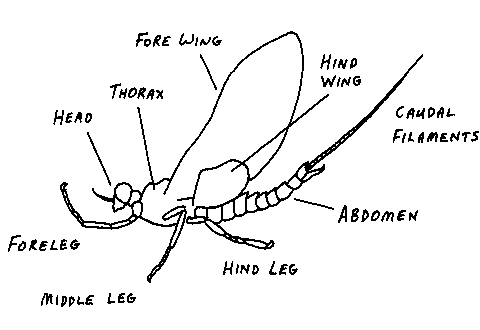
Unlike any other insect, mayflies have two winged stages: the dun (subimago) and spinner
(imago). Upon emerging from the final nymphal shuck, the (usually) sexually immature dun can be easily recognized because the entire
insect is covered by a dense layer of microscopic hair (microtrichia) which causes the insect to be waterproof and
probably prevents it from being trapped in the surface film. These microtrichia also cause the dun to have much less luster than the spinner. In
many species the dun emerges at dusk and transforms into the spinner before dawn. After shedding the subimago exoskeleton, the spinner, which
lacks microtrichia, appears glossy and its wings are often transparent (hyaline).
Adult- Anterior
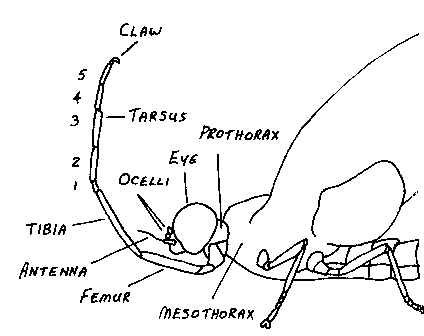
The head of the adult male and female are different: the eyes of the male being larger. The mouthparts are reduced and non-functional.
As in the nymph, each thoracic segment in the adult bears a pair of legs. The forelegs of the male are usually much longer than the middle- or
hind legs. In a few species the legs are much reduced. The mesothorax bears a pair of forewings and the metathorax
usually bears a pair of smaller hind wings which are much reduced or absent in some species.
Adult- Forewing
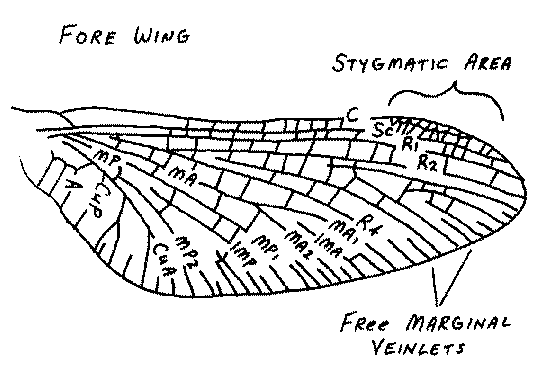
The major wing veins are known as costa (C), subcosta (Sc), radius (R),
medius anterior (MA), medius posterior (MP), cubitus anterior (CuA),
cubitus posterior (CuP), and anal (A). Intercalary veins (IMA, IMP) lie
between the major veins. The presence or absence of free marginal veinlets can be used to key some species.
Adult- Hind Wing
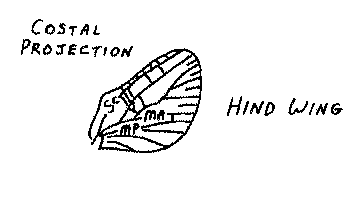
The angle of the costal projection on the hind wing can be a useful characteristic when keying some species.
Adult- Posterior
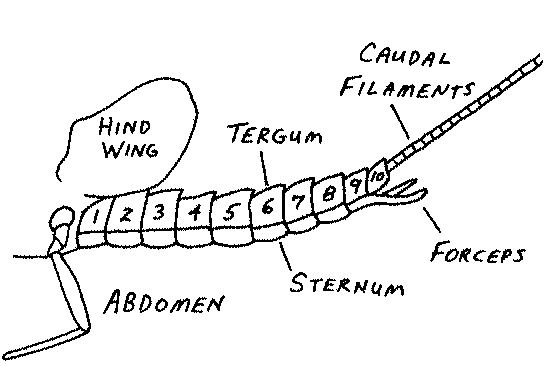
Each of the abdominal segments is composed of a dorsal tergum and a ventral sternum. Genitalia
are borne on the posterior portion of sternum 9 which is known as the subanal plate in the female and the subgenital plate in the male.
Adult- Penes
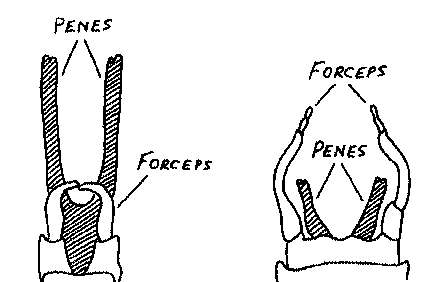
The subgenital plate bears a pair of forceps (or claspers) and a pair of penes.
Morphological Details Used to Characterize Mayfly Nymphs
Legs
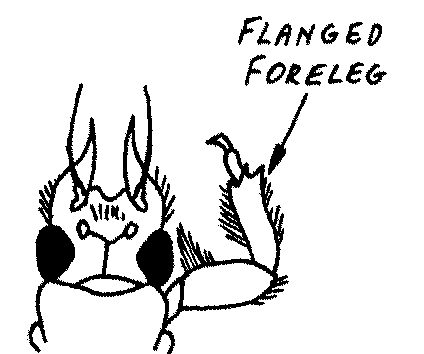
The legs of the nymphs of such genera as Ephemeridae and Potamanthidae are flanged to facilitate digging in the mud or sand at
the bottom of lakes or rivers. (Dorsal view)
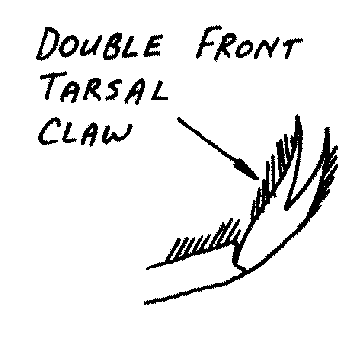
The tarsal claw on the foreleg of Siphloplecton is double.
Gills
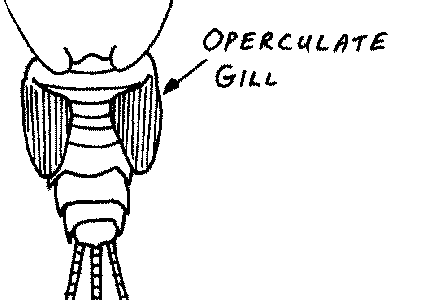
The form and location of the gills varies greatly and are a useful characteristic when keying mayflies. For example, the absence of gills on
abdominal segments 1 and 2 (and sometimes 3) is diagnostic of the Ephemerellidae.
Similarly, the shape of the large, operculate gills of Caenidae can be used to differentiate between Tricorythodes,
Brachycercus, and Caenis. (Ventral view.)
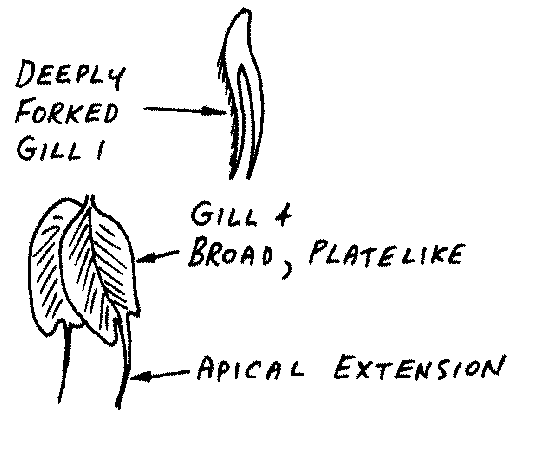
Whether the shape of the gills are uniform or not can also be used to characterize mayflies. For example, in Leptophlebia the gills
attached to abdominal segment 1 are deeply forked while those on segments 2-7 are flat, platelike and bear a long apical extension.
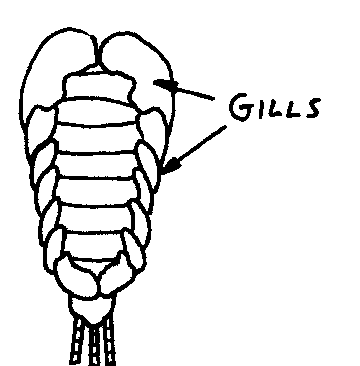
The gills of Rithrogena are enlarged and overlapping; forming an adhesive disk the nymph uses to cling to rocks in rapidly-flowing
water. (Ventral view.)
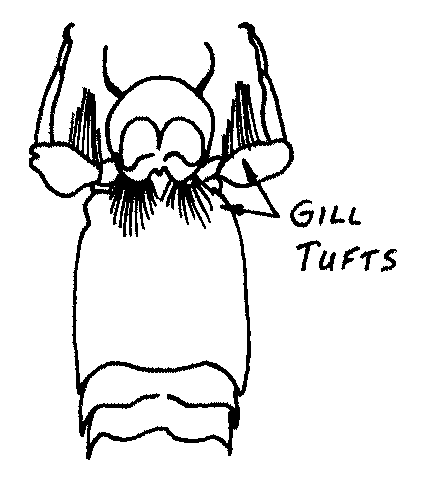
Nymphs of Isonychia exhibit gill tufts on their maxillae and the bases of their forelegs. (Ventral view.)
Head

The detailed morphology of the parts of the head can also be used to key mayflies. For example, the number of segments in the labial- and
maxillary palps, length of antennae, and the relative sizes of ocelli can be used to differentiate species. (Front view.)
Thorax
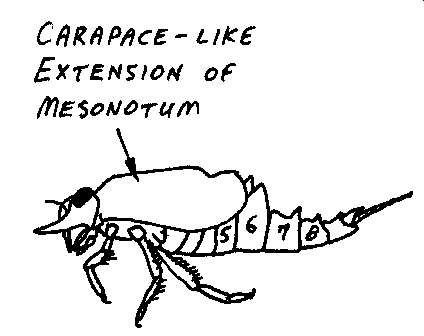
The distinctive carapace-like extension of the mesonotum is characteristic of Baetisca spp.
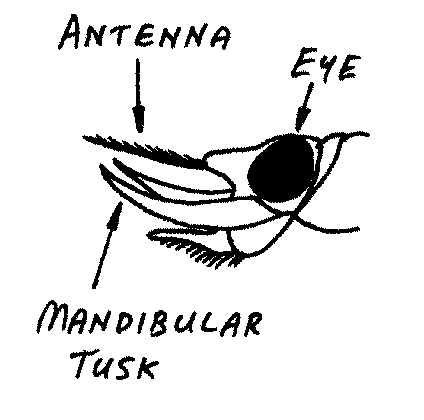
The presence of tusks and their shapes are characteristic of some species. (Side view of head of Ephemera nymph.)
Morphological Details Used to Characterize Mayfly Adults
Legs
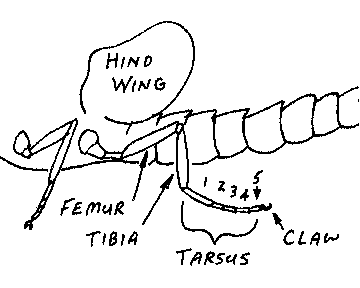
The relative sizes of the legs, their functionality, and the number and relative sizes of the segments can help key mayfly adults.
Veining of Wings

The exact pattern of veins in the wings are unique to each species. For example, the shape of a specific vein (designated
MP2) is characteristic of Ephemera.
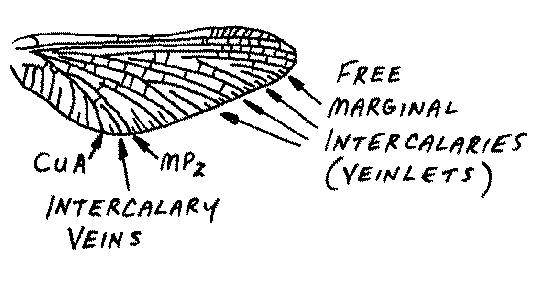
The presence of specific intercalary veins help identify the following mayflies: The fore wings of Ephemerellidae exhibit one or two
long, intercalary veins between the second medius posterior vein (MP2) and the cubitus anterior vein (CuA).
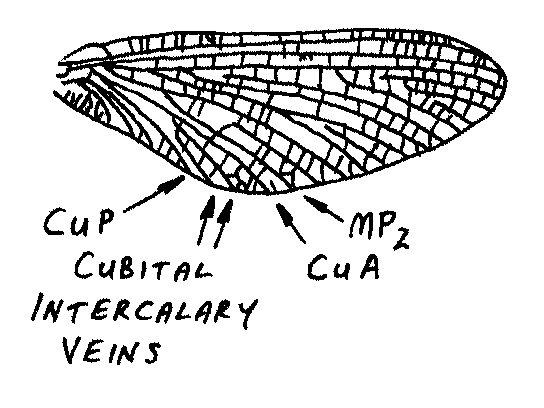
The forewings of Metretopus exhibit a single pair of cubital intercalary veins.
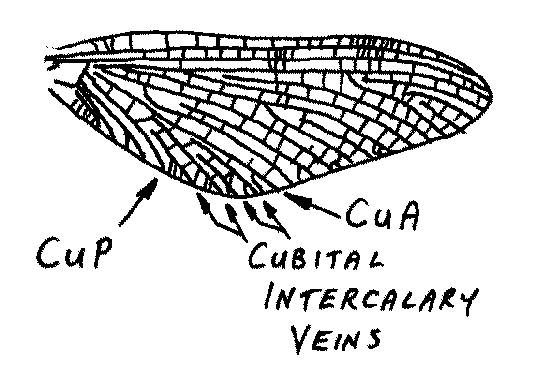
The forewings of Siphloplecton exhibit two pairs of cubital intercalary veins.
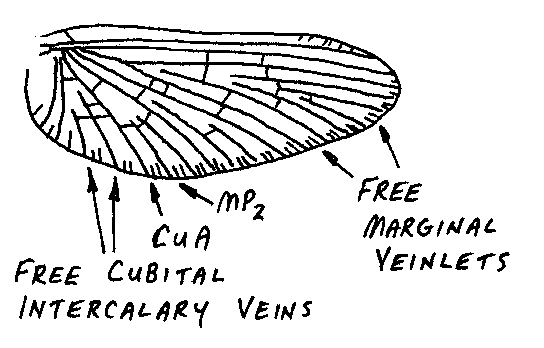
The presence or absence of cubital intercalary veins and free marginal veinlets differentiates Ametropidae from Baetidae.
Reproductive Organs
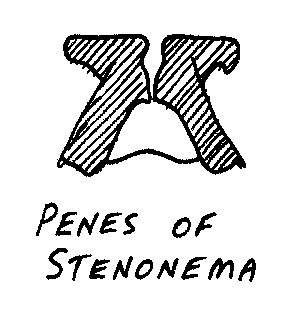
The reproductive organs, especially the size and shape of the forceps and penes are important taxonomical traits.
References:
Swisher D and Richards C, 1971. Selective Trout. Crown Publishers, Inc.
Edmunds GF and Waltz RD, 1990. Ephemeroptera IN: An Introduction to the Aquatic Insects of North America. ED: Merritt RW and Cummins KW.
Kendall/Hunt Publishing Company. pp 126-163.
last modified 6/11/04
Comments or suggestions:
bruce@fishermonk.com





























